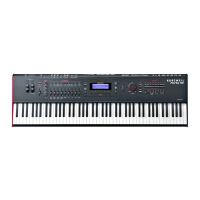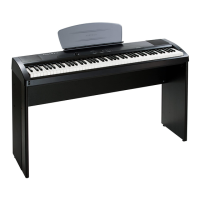Program Edit Mode
Editing VAST Programs With KVA Oscillators
3-73
Editing VAST Programs With KVA Oscillators
e PC4 uses KVA oscillators as another way to generate sounds in VAST programs.
Unlike keymaps, which play samples stored in ROM, KVA oscillators create DSP-
generated waveforms every time they are triggered. e KVA oscillators can create a range
of waveforms, from high quality simple waveforms familiar to users of classic analog
synths, to complex waveforms which take advantage of the PC4’s internal processing power
and complex signal routing capabilities. ough the PC4 does have keymaps containing
samples of basic synth waveforms, the use of KVA oscillators provides users with better
portamento, more modulation options, higher sound quality, and other advantages which
will be explained in this section. Learning to use KVA oscillators instead of keymaps (where
appropriate) is simple and will increase the versatility of your VAST editing capabilities.
VAST programs using layers with KVA oscillators can also be combined with other layers
using keymaps.
Basic Use of KVA Oscillators
Minimal Settings for Basic Use of KVA Oscillators:
ese are the minimal settings that a KVA layer needs in order to function in the style of a
classic analog synth:
1. Edit:Program Keymap Page: Set the Keymap parameter to 999 Silence.
2. EDIT:Program Amp Envelope Page: Set the Envelope mode to User, and adjust the
amplitude envelope to your liking (see The Amplitude Envelope (AMP ENV) Page on page
3-60).
3. EDIT:Program Wiring Alg Page: Pick an Algorithm and set an Oscillator (see Setting KVA
Oscillator Type on page 3-74).
Further basic VAST settings that you will likely want to adjust are:
• Monophonic On/O (see The COMMON Page on page 3-17)
• Level Velocity Tracking (see The DSP Control (DSP CTL) Page on page 3-53)
Read the Setting KVA Oscillator Type section below to learn about how to set each type of
oscillator. After doing this, you can experiment with making KVA programs by following the
above settings, and then setting and listening to each type of oscillator. Once you understand
how to do this, see Advanced Use Of KVA Oscillators on page 3-76 to learn how to make
your KVA patches more expressive through the use of DSP modulation.
Pitch Settings for KVA Oscillators
Each oscillator (except for noise functions) has its own pitch parameters, and is unaected by
pitch settings that would normally aect keymaps (such as those on the Keymap page). On a
program layer, the coarse pitch parameter for the oscillator in use can be found on both the
DSP CTL and DSP MOD pages, in the parameters list below the standard Pitch parameter

